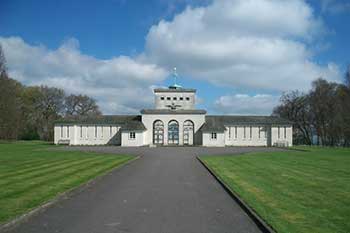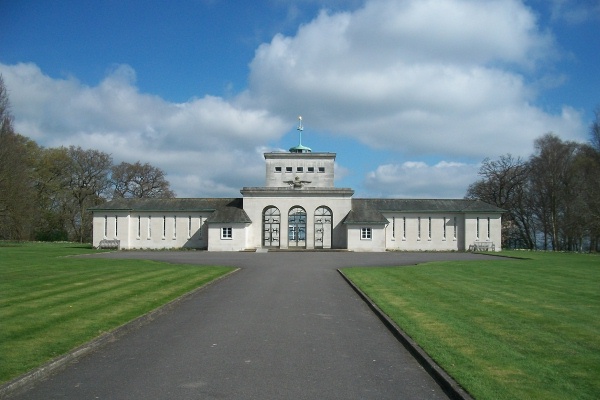During the Second World War more than 116,000 men and women of the Air Forces of the British Commonwealth gave their lives in service. More than 17,000 of these were members of the Royal Canadian Air Force, or Canadians serving with the Royal Air Force. Approximately one-third of all who died have no known grave. Of these, 20,450 are commemorated by name on the Runnymede Memorial, which is situated at Englefield Green, near Egham, 32 kilometres by road west of London.
The design of the Runnymede Memorial is original and striking. On the crest of Cooper's Hill, overlooking the Thames, a square tower dominates a cloister, in the centre of which rests the Stone of Remembrance. The cloistered walks terminate in two lookouts, one facing towards Windsor, and the other towards London Airport at Heathrow. The names of the dead are inscribed on the stone reveals of the narrow windows in the cloisters and the lookouts. They include those of 3,050 Canadian airmen.
Above the three-arched entrance to the cloister is a great stone eagle with the Royal Air Force motto, "Per Ardua ad Astra". On each side is the inscription:
In the tower a vaulted shrine, which provides a quiet place for contemplation, contains illuminated verses by Paul H. Scott, from whom the following extract has been taken:
"Here, at the heart of England, half-way between Royal Windsor and lordly London: looking down, Here, where the trees troop down to Runnymede, Meadow of Magna Carta, field of freedom, Never saw you so fitting a memorial, Proof that the principles established here Are still dear to the hearts of men."
Commonwealth and Allied Airmen*
The airmen named here came from all parts of Britain, from the other countries of the Commonwealth and Empire, and from the countries of Britain's Allies. Serving with the various Commands of the Royal Air Force, they flew over Northwestern and Central Europe, over the British Isles, and out over the Atlantic Ocean.
The men of Coastal Command kept their watch over the sea lanes, protecting the vital convoys, and waging their unceasing battle against the U-boat. Fighter Command gained its early experience in dealing with "hit-and-run" raids by German bombers coming in over the North Sea; but it was in the Battle of France that the skies over Dunkirk provided the first real test of strength between the Luftwaffe and the Royal Air Force. That summer of 1940 also brought the critical days of the Battle of Britain, when the hard-pressed pilots of Fighter Command earned Winston Churchill's famous tribute: "Never in the field of human conflict was so much owed by so many to so few."
Bomber Command's early reconnaissance missions and leaflet raids over Western Europe developed into the 1000 bomber attacks on enemy sea ports and industrial targets in the heart of Germany, designed to diminish the enemy's war potential and weaken the will of the German people to resist. Part of this programme of strategic bombing was directed at enemy airfields to reduce the Luftwaffe's fighter forces as a prerequisite to the invasion of Normandy in June 1944. With complete ascendancy over the German Air Forces established before D-Day, the landings were supported by an overwhelming number of sorties of all kinds.
During the Battle of Normandy and in the subsequent campaigns that led to final victory in Europe, the Allied armies received invaluable aid from the tactical air forces, including at times the employment of aircraft of Bomber Command in close support of assaulting ground forces. The Allied crossing of the Rhine in March 1945 was made in conjunction with the most successful airborne operation of the whole war. More than 1,550 aircraft of the Royal Air Force constituted the British share of the air transport and cover for the glider landing and parachute-drop of two airborne divisions on the far side of the river.
As the war ended, heavy bombers assumed a new role. They carried supplies to the starving people of Holland, and brought released prisoners of war home to Britain.
* Canadians who fell in campaigns at sea during the Second World War and who have no known grave are commemorated on the Halifax Memorial.
Directions
This Memorial overlooks the River Thames on Cooper's Hill at Englefield Green between Windsor and Egham on the A308, 4 miles from Windsor.

